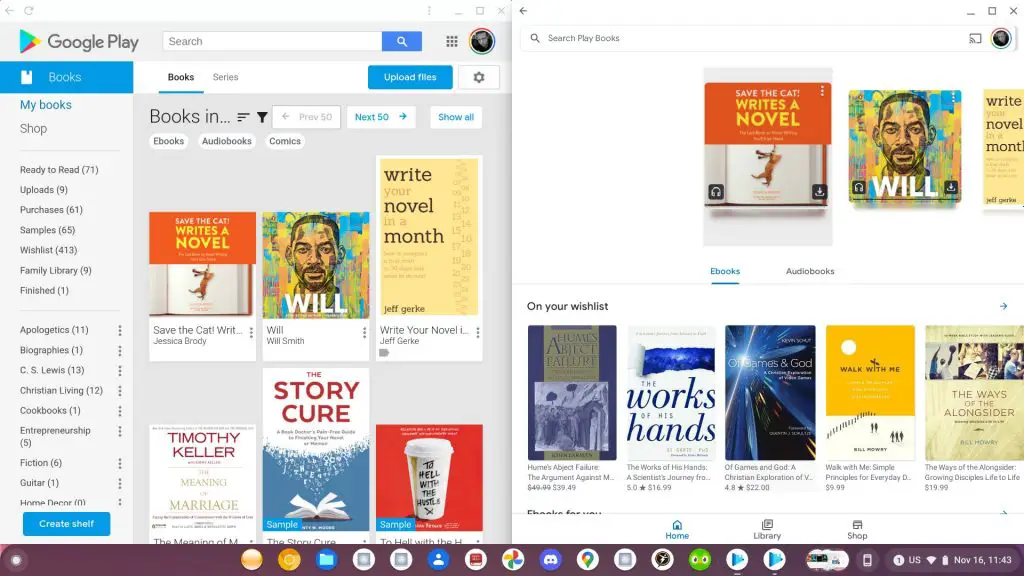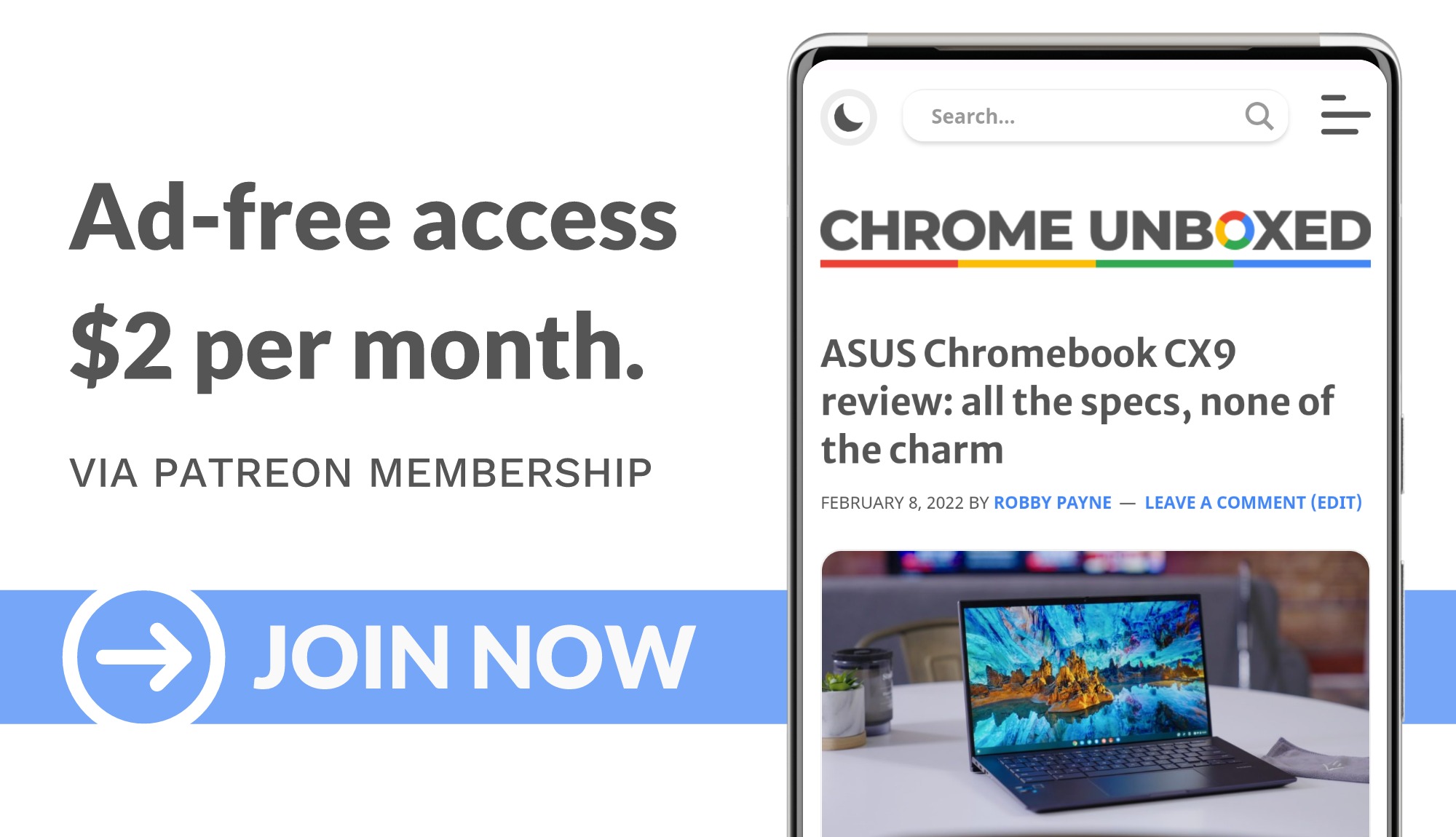
It’s officially been one year since Google Play Books turned 10 years old…now making it 11. Back when it cut into the cake, I wrote up a feature wishlist for the future, and on it, I included things like adding its new Shelves beta and a redesigned interface to the web, among other things. While we did finally get Shelves to appear on the web, which made me very happy, especially as a lover of Amazon’s Shelfari in the past, the tally isn’t largely in the app’s favor as we move into the new year.
The reason that I’ve circled back around to this idea of using Google Play Books on the web as opposed to the Android app version aside from my love for PWAs is that I own a Lenovo Chromebook Duet. That should say it all, but I’ll still explain – the Duet is notorious for sucking down RAM like your rich aunt treats champagne at the family Christmas party.
As a result, I’ve only been able to increase performance to where the device is usable at all by completely disabling the Google Play Store and Play Services entirely. It’s unfortunate, but I don’t really play games (besides cloud gaming!) on it, and I use it primarily for youtube, news, and well, reading books, of course.
That’s where the issue comes in – I can no longer use my Duet with the Google Play Books app, and instead, I’ve been forced into using the web app in its place. In doing so, I’ve realized just how truly awful the PWA experience is. With all of the advancements and hype around progressive web apps, you’d think that the company would throw some paint on something as important as Books, and maybe even do a few things under the hood. Today, I’d like to take a moment to look at how the service has done over the last 365 days and offer five more major thoughts about how the company can bring Play Books out of the Stone Age.
Interface redesign
I know I covered this one on the last round of improvement suggestions, but there’s a reason I’m trudging it back up again. Recently, the Google Play Store began to receive a progressive web app visual refresh and the web version of the store in Thailand and Korea now looks virtually identical to the Android app version of the store. Actually, in some areas, it looks better!
As a natural extension of that, I’m expecting us to finally get the aforementioned Play Books web redesign for your library. Now, there’s always that chance that said interface remains antiquated, and the Books storefront only gets redesigned, but that would be inconsistent…and Google isn’t inconsistent…right?
A proper PWA icon
Riffing off of the recent Play Store redesign and its potential to bleed into Play Books, I wanted to point out something I recently noticed. Now, this could have been a total fluke, but I was using both the Play Books PWA and Android app simultaneously on Chrome OS Canary a few weeks ago, and instead of showing me the generic Store logo, Play Books on the web shared the official logo that the Android app uses!
You can see below in the image that at the bottom-right of my device’s shelf, both of the side-by-side windows are rocking the same blue Play Books triangle. I noticed this regarding the Play Movies PWA as well – it shared the Play Movies app logo! After a few restarts, they all reverted back to generic Store logos for their respective web apps, but instead of thinking some wires got crossed, I like to believe that Google let slip something of their plans for the future.
Think about it – a completely redesigned web-based Play Store naturally warrants a Books redesign as I’ve previously stated, and by extension, it will need a new icon to indicate that the web app is installable, right? I honestly think that we’re just a few years or less away from the Google Play Store being removed from Chromebooks in place of its own PWA. You can already install apps to any device on your account from the web, and if it looked and felt, and even acted like the installed version, then what reason would the company have for keeping it installed as a local package?
To me, web apps are absolutely the future, and I think these small details gleaning through indicate to me that we’re on the verge of a major shift here. Again, my Lenovo Chromebook Duet isn’t powerful enough to use the Play Store, so having Play Books on the web means that my experience wouldn’t be missing anything I do on a normal day. Right now, I am!
Better page turning
While launching a book on the web for reading, I noticed a few inconsistencies in the navigation tools. First, while swiping to go to the next page does, in fact, do what it’s supposed to do, swiping to the previous page on screen causes you to not only go back to the previous page, but it also exits the book! This is happening because the Duet and other Chrome OS tablet-mode Chromebooks rely on a left-to-right swipe of the finger from the left half of the screen in order to “go back” in apps and in Chrome.
Obviously, this is problematic that there are two functions tied to one action, but at this time, I don’t think that can be helped. Instead, I think Google needs to allow you to adjust the edge swipe sensitivity on Chrome OS or intelligently adjust it while you’re using apps that need the same gesture. The more user-friendly update would be to create a system-wide toggle for enabling or disabling it as well as sensitivity controls, but I’m not betting on that any time soon.
Another update that needs to occur for the web-based reading experience is the page turn animation. As of right now, it’s completely absent online, even though it’s available in the app. You may say that this is because the web isn’t powerful enough or something like that, but that couldn’t be further from the truth. A simple page turn animation would make it feel more like you’re reading a book and less like a web article, and it’s absolutely doable. Its absence just shows a lack of initiative on Google’s part to make the web version of the service, well, serviceable.
Makes you go back instead! Because of this, I wasn’t even aware that you could swipe. I was using the tiny, unintuitive arrows at the bottom of the screen to flip the page…Perhaps they can disable back swipe or make more intelligent edge detection for Chrome OS depending on the application you’re in.
Lastly, page turning requires you to use the tiny, little arrows at the bottom-right of the screen a la 1999, even though swiping through pages is possible (but terrible). It really tears you out of the immersion of whatever you’re reading if you have to constantly aim your finger at such a tiny little on-screen button, and above all else, it just reminds you that you’re using a crappy web reader.
Audiobook player rework
The Google Play Books audio reader isn’t much better. Now, this may just have been my experience, but I thought I would cover it here to be sure. Launching an audiobook on the web looks relatively nice and put together, but the playback control buttons are constantly hidden under my Chromebook’s shelf! Resizing the window does not resolve the issue, and that took me by surprise. Clearly, minimal effort has gone into this, and that’s probably because Google never anticipated that people would use this on their desktop. However, we’re in a different era now, and things have changed quite a bit. Here’s to hoping that in 2022, Google takes notice of this and makes the appropriate changes.
My last gripe with the audiobook player in the PWA is that scaling the window does not cause any of the elements – the book cover, the chapters, or the playback controls – to intelligently re-order themselves in any meaningful or fluid way. This sort of technology has been around for two decades, so why isn’t it implemented here?
At the end of the day, Google Play Books has done a fairly poor job at updates in 2021, and I hope to see that change during this new year. One can only hope, right? The good news is that with the Play Store redesign on the web, the rise of web apps, and even the many apps on the store being replaced by PWAs, I think that there’s some hope for my favorite reading experience. Let me know in the comments what you think about all of this and if you’ve tried to use Play Books on the web in place of the Android app. If so, was your experience as bad as mine?





Leave a Reply
You must be logged in to post a comment.